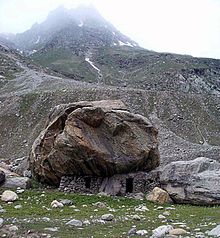Rock shelter


A rock shelter (also rockhouse, crepuscular cave, bluff shelter, or abri) is a shallow cave-like opening at the base of a bluff or cliff. In contrast to solutional caves (karst), which are often many miles long or wide, rock shelters are almost always modest in size and extent.
Formation
[edit]Rock shelters form because a rock stratum such as sandstone that is resistant to erosion and weathering has formed a cliff or bluff, but a softer stratum, more subject to erosion and weathering, lies just below the resistant stratum, and thus undercuts the cliff.
In arid areas, wind erosion (Aeolian erosion) can be an important factor in rockhouse formation. In most humid areas, the most important factor in rockhouse formation is frost spalling, where the softer, more porous rock underneath is pushed off, tiny pieces at a time, by frost expansion from water frozen in the pores. Erosion from moving water is seldom a significant factor.
Many rock shelters are found under waterfalls.
- Rock shelter formation types
-
By cutting a karst gallery
Human habitat
[edit]


Strouds Run State Park
Rock shelters are often important archaeologically. Because rock shelters form natural shelters from the weather, prehistoric humans often used them as living-places, and left behind debris, tools, and other artifacts. In mountainous areas the shelters can also be important for mountaineers.
Transhumant nomads, people who move with their livestock - often from lower permanent winter residences in the valleys to higher summer pastures - frequently build semi-permanent camps, often of rocks.
In western Connecticut and eastern New York, many rock shelters are known by the colloquialism "leatherman caves",[1] as they were inhabited by the Leatherman over three decades in the late 19th century.
Unique vegetation
[edit]The Cumberland stitchwort (Minuartia cumberlandensis) is an endangered species of plant which is found only in rock shelters in Kentucky and Tennessee.[2]
See also
[edit]- Bhimbetka rock shelters – 30,000+ years old archaeological World Heritage site in Madhya Pradesh, India
- Fincha Habera Rock Shelter – Middle Stone Age archeological site in southern Ethiopia
- Gatecliff Rockshelter – Archaeological site in the Great Basin area of the western United States
- Kinlock Shelter – Rock shelter and Native American cultural site in Alabama
- Mesa Verde National Park – U.S. national park in Colorado
- Overhang (architecture) – Architectural Roofing Feature
- Roc-aux-Sorciers – Cave and archaeological site with prehistoric art in France
- Rock shed – Road protection structure
- Shelter Rock – Rock shelter in Nassau County, New York, USA
- Simple dolmen – Early form of dolmen or megalithic tomb
- Walnut Canyon National Monument – Protected area in Coconino County, Arizona
References
[edit]- ^ CT Museum: Leatherman Caves
- ^ Center for Plant Conservation Archived 2010-12-15 at the Wayback Machine
Further reading
[edit]- Acosta et al., 2018. "Climate change and peopling of the Neotropics during the Pleistocene-Holocene transition". Boletín de la Sociedad Geológica Mexicana.
External links
[edit] Media related to Rock shelters at Wikimedia Commons
Media related to Rock shelters at Wikimedia Commons
| Natural features |
| ||||
|---|---|---|---|---|---|
| Man-made features |
| ||||
| Fictional features |
| ||||
| Organisations |
| ||||
| Related topics | |||||
Text is available under the CC BY-SA 4.0 license; additional terms may apply.
Images, videos and audio are available under their respective licenses.

